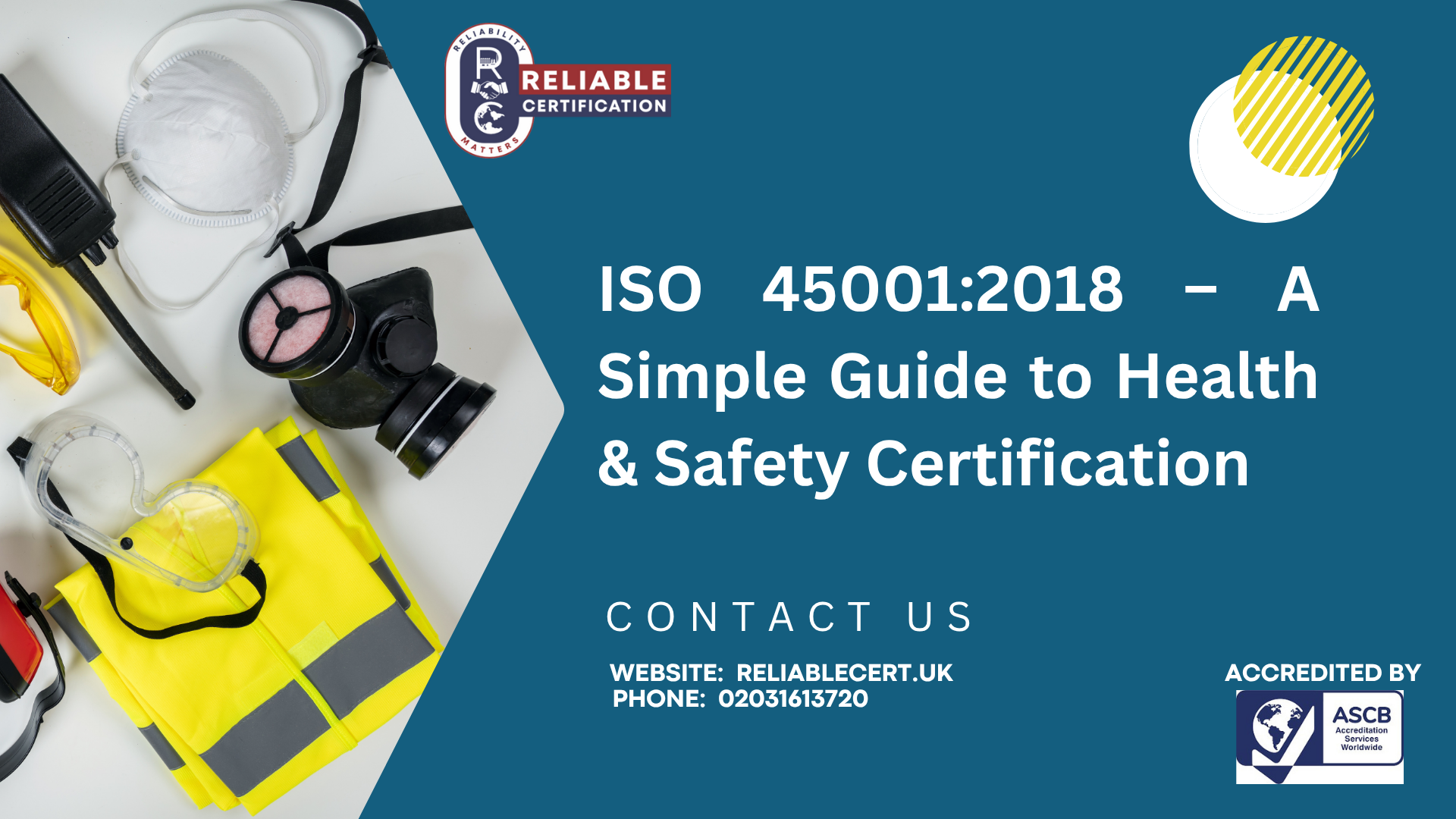ISO 45001 is the globally recognized standard for occupational health and safety. It is a stamp of approval that tells the world and especially your workers, that your company is safe to work at. An ISO 45001 certification helps you better manage Health & Safety related risks with lower associated costs.
Your business needs a solid framework for risk management and shows better commitment towards health and safety. Reliable Certification can help. Learn more about ISO 45001:2018 and what it can do for your organization. Get a quote today!
 ISO 45001
Occupational Health & Safety
ISO 45001
Occupational Health & Safety
By submitting your information, you are agreeing to our Terms & Conditions and our Privacy Policy.
ISO 45001 is specifically designed to mitigate risks associated with the workplace. It is the first-ever standard of its kind and helps organisations of all sizes create safer working environments. By implementing the ISO 45001 standard, organisations can make their work environment safer, protect employees, and comply with legal requirements.
ISO 45001 provides a strategic approach to managing health and safety across the workplace by identifying potential hazards. By identifying potential hazards, you can implement preventive measures which can in turn help create a culture of well-being. This standard is based on the PDCA (Plan-Do-Check-Act) cycle that enables organisations to achieve continual improvement in their OH&S performance.
By achieving this certification, you can improve your organisation’s reputation by demonstrating your care for employee safety and well-being. ISO 45001 also helps you reduce workplace accidents and improve operational efficiency which helps comply with regulations. No matter if you run a large organisation or a smaller one, this standard can be tailored to your specific requirements.
Achieving ISO 45001 certification holds a lot of benefits for your organisation. Here are some of the benefits you can get.
Improved Workplace Safety: ISO 45001 provides a complete framework for identifying and controlling risks related to the workplace. This can reduce the likelihood of accidents and injuries which in turn improves the safety of your workplace.
Compliance with Legal Requirements: It is essential for any organisation regardless of size to comply with health and safety regulations. By achieving ISO 45001 certification, you can demonstrate your compliance and avoid potential penalties and legal issues.
Cost Reduction: Achieving this certification can help you reduce costs. By implementing this standard, you can prevent accidents and minimize downtime. Also, you can reduce costs associated with insurance, legal fees, and other expenses associated with workplace incidents.
Proactive Risk Management: ISO 45001 emphasizes hazard identification and preventive measures. This enables your organisation to address risks before they escalate making them easier to manage. With this approach, you can ensure the safety of your employees and organisation.
Global Recognition: If you are thinking of targeting the global market, achieving ISO 45001 certification can be a great step. It is an internationally recognised standard and demonstrates that your organisation cares about the safety of its employees. This can get you faster acceptance and better credibility in the international market.
Stronger Stakeholder Trust: Achieving ISO 45001 sets your organisation as one that prioritises health and safety. This approach can build trust and credibility with employees, customers, partners, and other stakeholders.
Prices to gain ISO 45001 certification will vary based on the size and complexity of your business.
To receive your personalised quote, simply fill in your details in our form above.
Complete the form to receive your instant quote
Prefer to talk face-to-face? If you’d prefer a no-obligation video conference call, please call 0231613720
To successfully achieve an ISO 45001 certification, organisations must consider the following requirements for their OH&S management system.
Organisational Context: Organisational context refers to the internal and external factors affecting your operational health and safety. You need to identify these factors along with the expectations of your workers and other stakeholders. Based on these factors, you need to define the scope of your OH&S management system.
Leadership and Worker Participation: The top management should participate by showcasing their commitment to operational health and safety. With this commitment, the leadership should develop an operational health and safety policy that aligns with the organisations goals. The leadership should assign roles and responsibilities at all levels of the organisation along with promoting worker participation in decision-making and hazard identification.
Planning: For this requirement, your organisation should go with a strategic approach to identify hazards, assess risks, and determine opportunities for improvement. You also need to ensure that your organisation complies with all applicable legal and regulatory requirements. Based on this approach, develop objectives and plans to achieve desired OHS outcomes.
Support: Your organisation needs to provide the required tools for implementing the OH&S management system. This support can consist of training key staff regarding operational health and safety, providing personal protective equipment, and clearly communicating your goals with the staff.
Operation: To comply with this requirement, you need to have the required knowledge to assess risks and hazards. Based on this knowledge, you need to take measures to mitigate those risks. Your organisation should also be prepared and have the proper knowledge to deal with emergency risks.
Performance Evaluation: For this requirement, you need to do a thorough performance evaluation of the OH&S management system. This can be achieved by performing internal audits to ensure that your management system works. Internal audits also help you identify key areas for improvement. You also need to ensure that your OH&S meets regulatory requirements.
Improvement: This is a key requirement on the way to achieving ISO 45001 certification. Your organisation should show a commitment to continuous improvement. You need to implement a system for quickly identifying and addressing non-conformities. You also need to take corrective measures to ensure the issues do not occur again.
With the help of Reliable Certification, the certification process can take as little as 45 days to complete
Yes, ISO 45001 can be integrated with other management systems like ISO 9001 or ISO 14001. This creates a unified management system.
An ISO 45001 certification is valid for three years. However, organisations must go for annual surveillance audits to maintain their certification status.
The audit process involves different steps for evaluating your OH&S management system to ensure compliance with ISO 45001 requirements. These steps include reviewing documentation, inspecting facilities, interviewing employees, and more.
ISO 45001 is an improvement over OHSAS 18001 with a stronger focus on organisational context, leadership commitment, and risk-based thinking. This standard aligns with other ISO standards such as ISO 9001 and ISO 45001.
The simple answer would be, No. Implementing this standard or complying with it is voluntary. However, many organisations across different industries choose to get certified. It helps build trust and credibility.
The cost of this certification can vary depending on several factors including organisational size, the certification body, the complexity of operations, and more. Get in touch with us for a customised quote.
This time can highly depend on several factors. Some of these factors include the complexity of your organisation, size, and more. System development, implementation, and auditing can take anywhere around 3-6 months based on all factors.
Any organisation regardless of the size or industry can apply for ISO 45001 certification. This standard is highly adaptable and required in diverse sections including manufacturing, construction, healthcare, services, and more.
ISO 45001 is the internationally recognised standard for operational health and safety. Achieving this certification shows your commitment to the safety of your workplace and the workers.
 How ISO Certifications Protect Workers from Common Construction Hazards
How ISO Certifications Protect Workers from Common Construction Hazards
Get to know how ISO certifications help construction companies prevent hazards, improve safety, protect workers, and meet legal requirements, practical guide for UK businesses.
 ISO 45001:2018 – A Simple Guide to Health & Safety Certification
ISO 45001:2018 – A Simple Guide to Health & Safety Certification
Understand ISO 45001:2018 and how your business can create a safer workplace. Learn key requirements, benefits, and steps for OHSMS certification.
Typically replies within 30 minutes